Your browser is out-of-date!
Update your browser to view this website correctly. Update my browser now
Motherwell and Exhibitions
by Bruce Altshuler
Bruce Altshuler is Clinical Professor Emeritus of Museum Studies at New York University, where he was Director of the Program in Museum Studies from 2000 to 2021. He was Director of the Isamu Noguchi Garden Museum from 1992 to 1998 and has published books on Noguchi, the history of exhibitions, and the history of museums.
In considering Robert Motherwell through the lens of exhibitions, it is important to look at the ideas surrounding his artmaking and its presentation to the public. A voluble intellectual whose artwork is embedded in a rich conceptual landscape, Motherwell came to painting with a wide-ranging background in literature and philosophy. His literary interests and his studies in philosophy, as an undergraduate at Stanford and a graduate student at Harvard, were critical both to his thinking about art and to his artistic practice.[i] These ideas and ways of working, in turn, would be manifested in his exhibitions.
During his year of graduate work at Harvard, Motherwell found a congenial mentor in David Wight Prall, who had a formalist orientation centering on the “surface” of things, on the features of the objects of our experience as immediately felt. But Prall went beyond a formalism of shapes and colors to include feelings and the emotional qualities of works of art.[ii] And feeling would come to play a primary role in Motherwell’s view of his own painting and in the installation of his works in exhibition. While at Harvard Motherwell also attended Alfred North Whitehead’s lectures (later published as Modes of Thought), and he later credited Whitehead with defining abstraction for him, as a process of subtraction and of emphasis through selection. And using notions that he associated with Whitehead, Motherwell would view paintings as relational structures. He came to understand, as he later said, that “‘meaning’ was the product of the relations among elements,”[iii] and that the decisions involved in the creation of such relational structures were “ultimately made on the grounds of feeling.”[iv]
Motherwell was also well-versed in poetry, and had a special interest in French Symbolism. The poet and curator Frank O’Hara, who organized Motherwell’s 1961 presentation at the 6th São Paulo Bienal and his 1965 retrospective at the Museum of Modern Art, recalled that their first extended conversation was primarily about poetry.[v]
Another factor in Motherwell’s thinking about exhibitions came from his involvement with one of the most important modern art displays of his time, Frederick Kiesler’s innovative design for Peggy Guggenheim’s Art of This Century gallery, where Kiesler’s designs for the Surrealist and the Abstract Galleries reflected the imagery and mood of what was installed. Motherwell’s later thinking about his own exhibitions would involve an analogous unity of exhibition form and content, not with respect to similarity of visual form but in terms of the basis of curatorial decisions and a correspondence of values. Motherwell was one of the three Americans invited to show at Guggenheim’s 1943 collage exhibition (for which he made his first collage), and had his first solo show there the following fall.
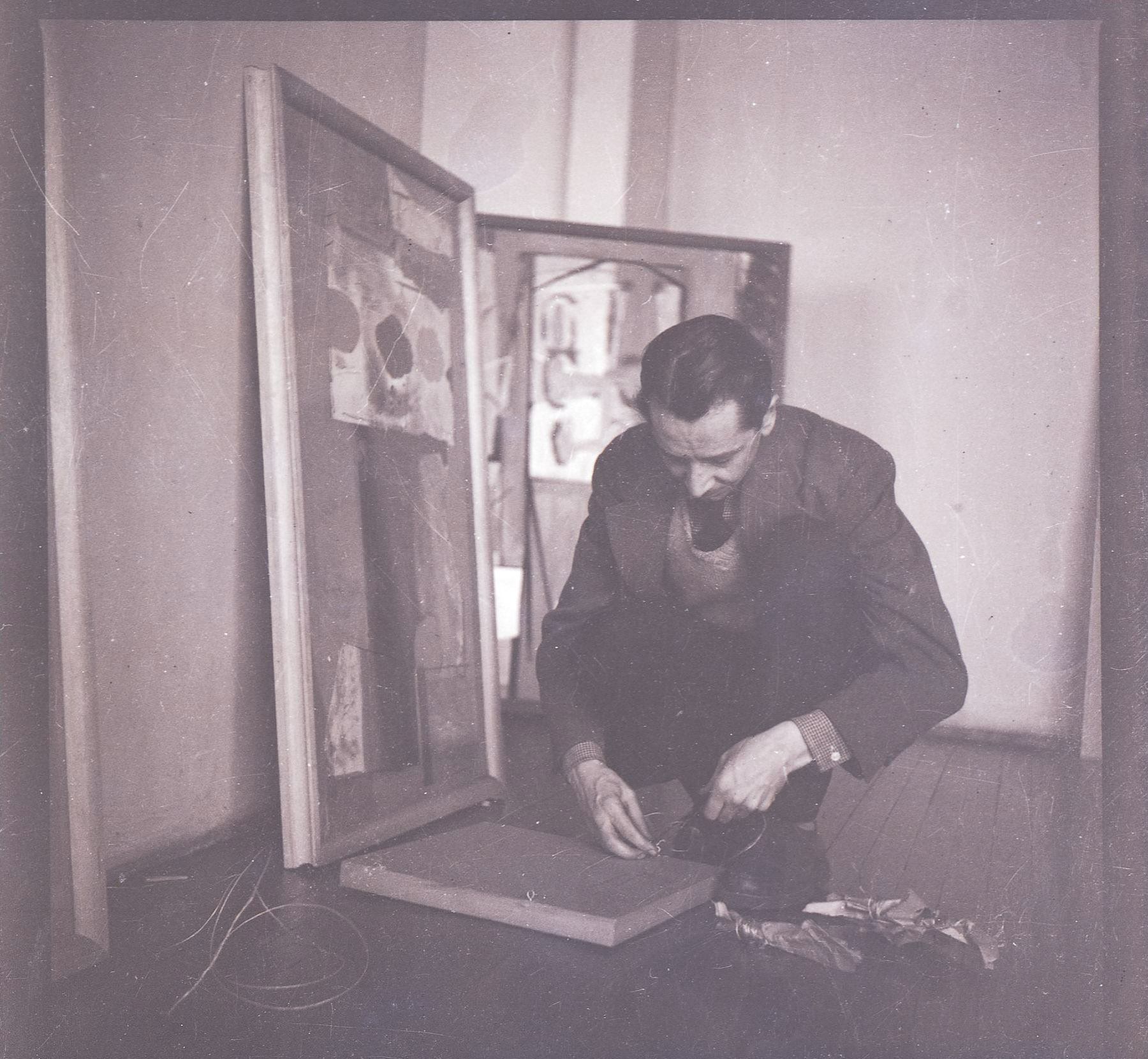
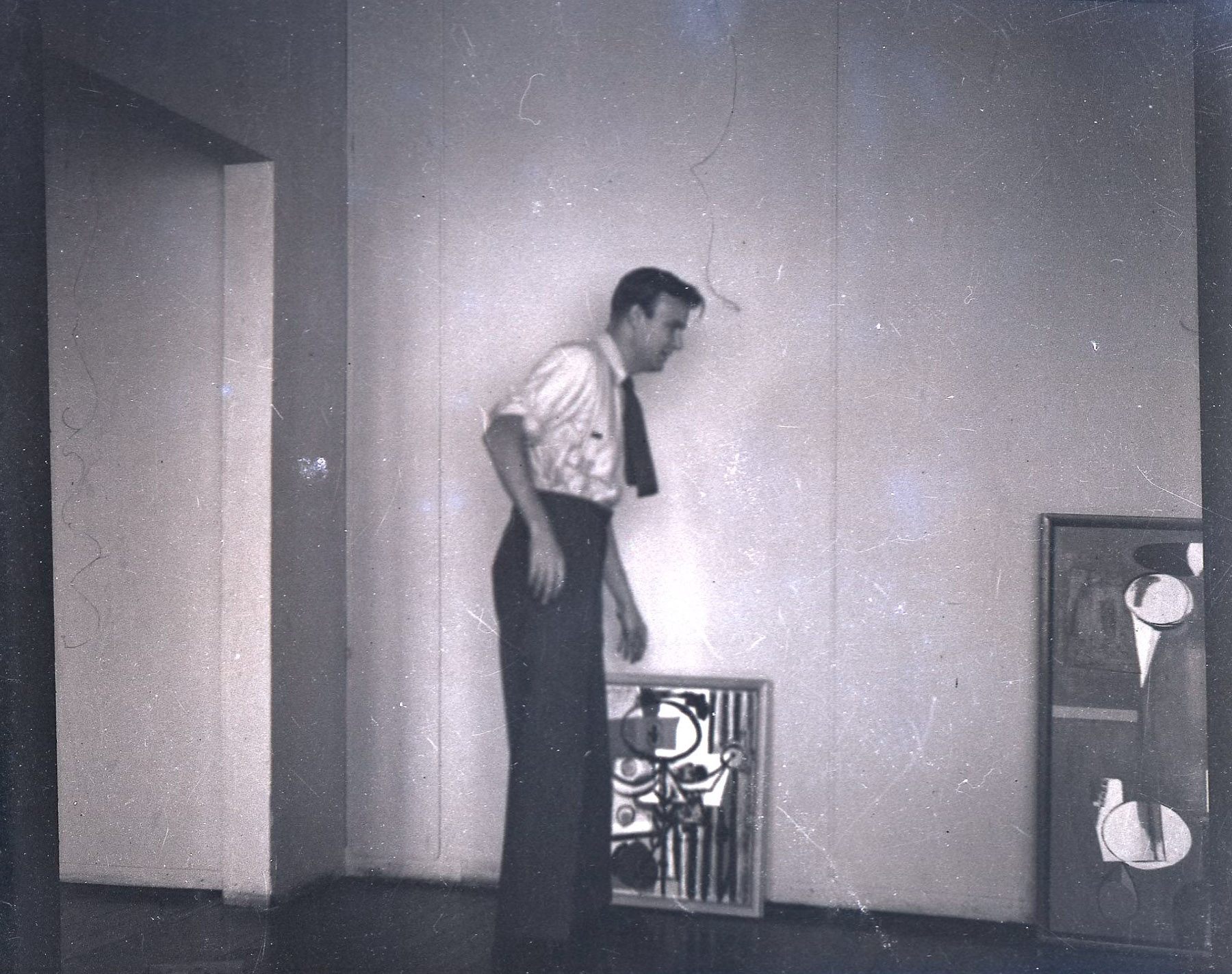
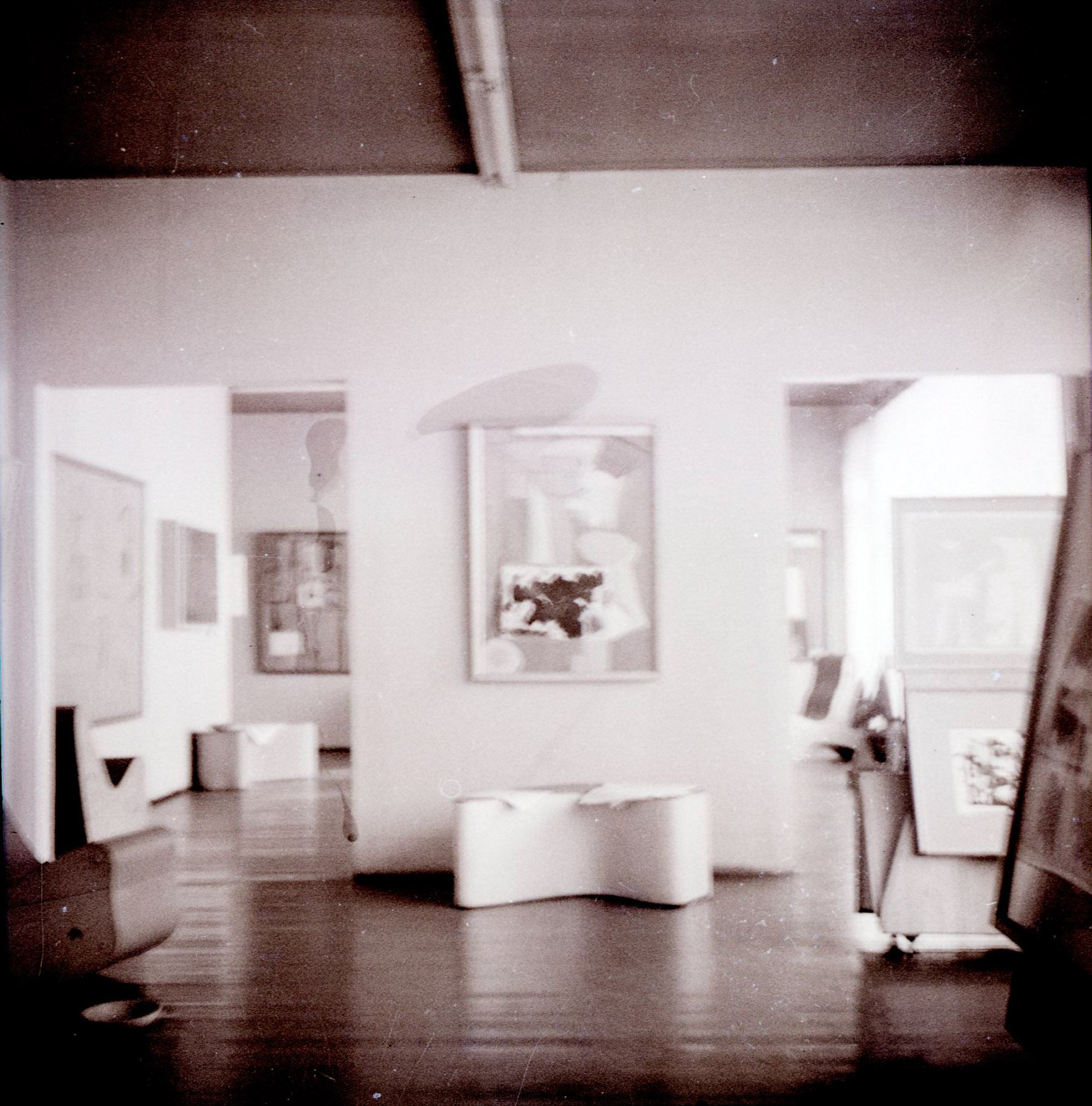
While he did not often address exhibitions per se, in a 1961 article written for Art in America he advanced the highly unconventional idea that instead of individual museums showing the work of many artists, it would be better to reorganize U.S. public collections so that the work of individual artists would be concentrated in particular museums: all Matisses going to one museum, for example, and the Rembrandts going to another.[vi] That notion brings to mind Donald Judd’s view that artists should be seen in depth, their works not mixed in the same space with those of others — something that Judd realized to dramatic effect at the Chinati Foundation in Marfa. Though Motherwell and Judd were very different kinds of artists and spoke of art in different ways, it should be noted that they each had studied philosophy seriously and wrote extensively about the work of their peers; and that in museums they both valued the artworks themselves more than their histories. In Motherwell’s terms, “one experiences nothing of art from the history of objects. The issue is passion, whether quiet or wild. Museums distort the history of artistic passion, just as do the societies which museums reflect.”[vii]
A few years after he published his Art in America article, Motherwell came up against institutional resistance in a museum that he had identified as the exception to the rule: the Museum of Modern Art, which offered him a retrospective there that was to open the fall of 1965, his fiftieth year. He initially welcomed the choice of Frank O’Hara as curator, as he expected that O’Hara would approach the show as a poet rather than as an art historian.[viii] But O’Hara, according to Motherwell, sought a chronological presentation in which a large number of works were intended to display the artist’s development. And with a few exceptions the show was to be presented chronologically, beginning with pieces from the early forties.[ix] O’Hara also wanted to display several large works from his renowned Elegies to the Spanish Republic along a single long wall.[x] Motherwell ultimately would not be happy with this dramatic presentation of the Elegies, feeling that it dissipated the intensity of the individual paintings.
During the final planning and installation of the show, however, Motherwell focused his concern on the total number of works, and he lobbied for the removal of many of them. O’Hara pleaded inability to cut the show’s size, since loan agreements already had been signed. This made it impossible to edit the exhibition in the process of installation, which Motherwell compared with being unable to alter a work of art as one made it.[xi] For he wanted the exhibition to yield an experience and not a document. “The point of art is to have an aesthetic experience. I mean not to look at somebody’s biography…. I mean my art is about feeling organized in a certain way, and there’s no point in showing anything that doesn’t do that at its maximum intensity. And that’s all I wanted the show to be.”[xii] Essentially, he viewed the exhibition as analogous to an artwork that would be revised continuously in the course of its creation, a work intended to provide a unified and concentrated aesthetic experience.
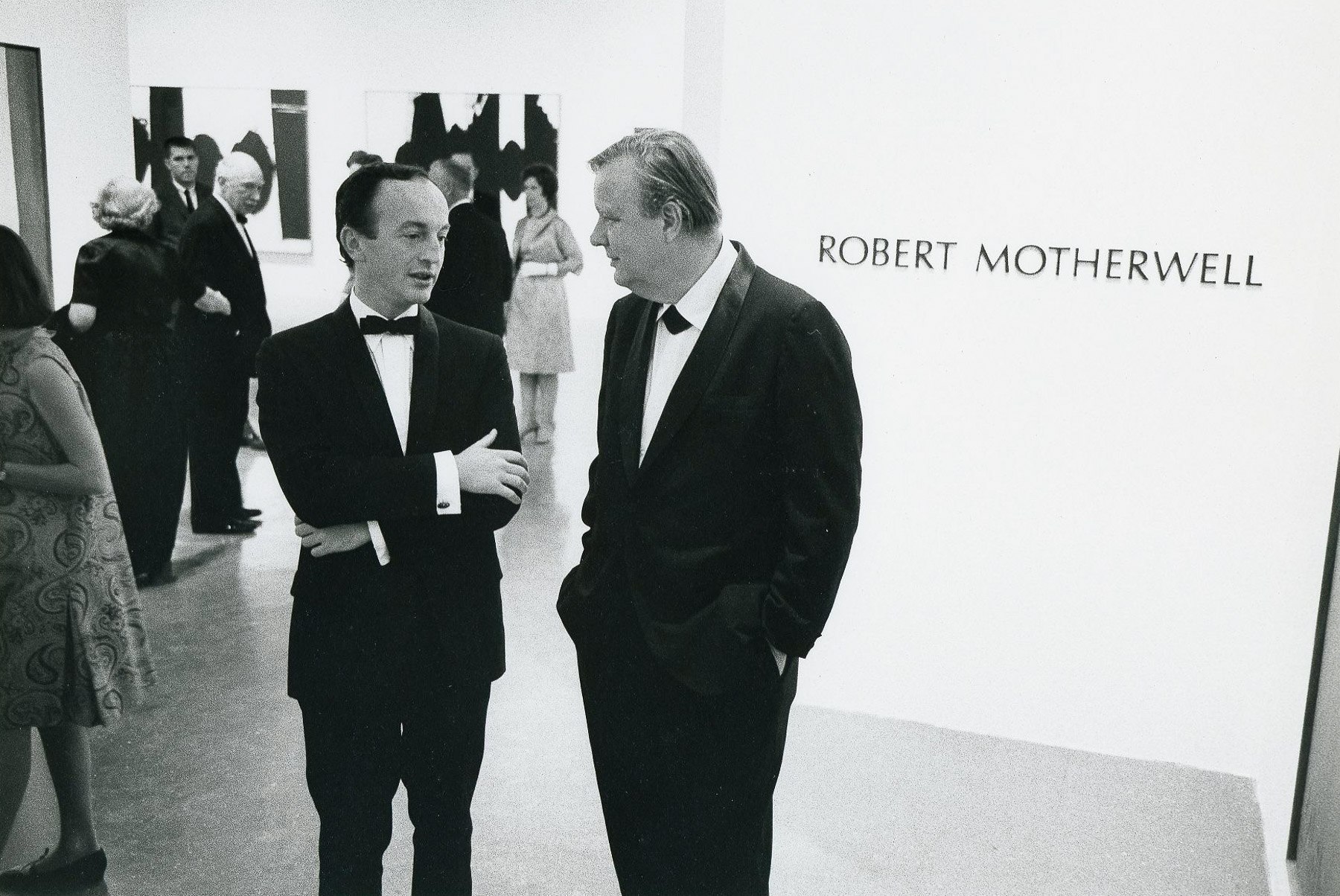
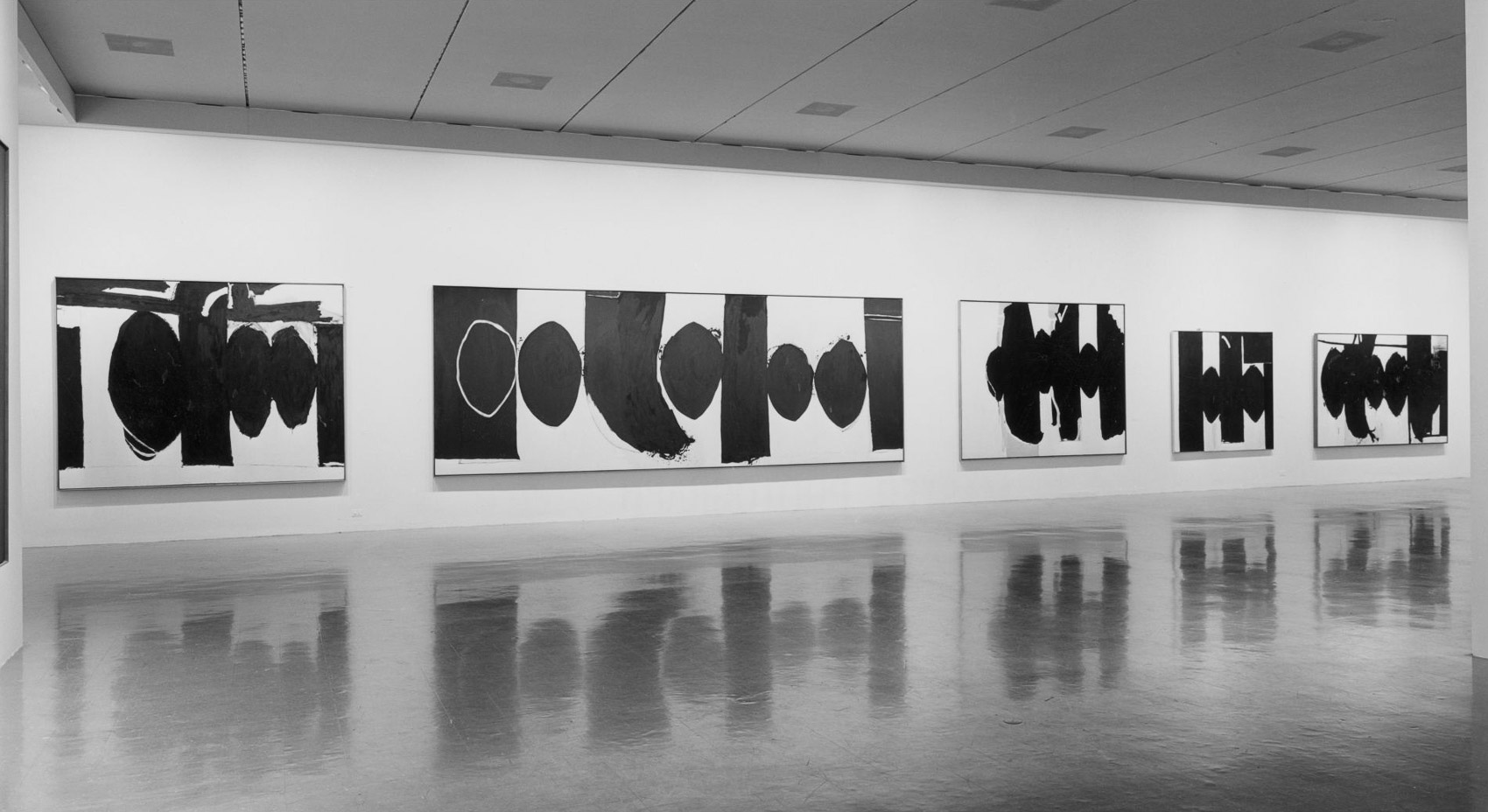
The issues involved here lay at the root of the history of the display of art collections. In the earliest paradigm, embodied in the presentations of the early European princely collections, the overall visual effect was paramount. But with the Enlightenment came more rational arrangements, based on historical framing with pedagogical purpose.[xiii] The paradigm here is Christian Mechel’s late 18th-century reorganization of the Habsburg royal collections in Vienna, with pictures divided into German, Dutch, and Italian schools presented chronologically by artist. Here it should be said that Motherwell was not alone in his preference for the older model. A contemporary reaction resonates with Motherwell’s thinking about art-historical display: “Why should the art lover, the true connoisseur of the good and beautiful, care about …chronological order…?”[xiv] This tension between the aesthetic and the educational would resurface regularly in the history of exhibition. An example that Motherwell would have appreciated is the contrast between Aleksandr Rodchencko’s conceptually-driven installation of work in the Museum of Painterly Culture in Moscow in 1920, with the gallery that was installed by Vasily Kandinsky and Robert Fal’k in a way that was determined “simply by feeling,” according to Varvara Stepanova, with the result like “the composition of a painting.”[xv] Stepanova’s description of Kandinsky and Fal’k’s curating find echoes in Motherwell’s approach to his own exhibitions.
Because the MoMA retrospective was to travel to five European venues during 1966, Motherwell again attempted to reduce the number of works from the eighty-seven shown in New York. His request prompted Edy de Wilde of the Stedelijk Museum to comment that he is the only artist who has asked him to put less of their work in an exhibition.[xvi] While not all pieces traveled to Europe, the number of works remained large. And there were, of course, significant changes in the installation as the show moved to new gallery spaces. For instance, the Elegies to the Spanish Republic presented by MoMA on a single wall were dispersed across multiple rooms at the Whitechapel Gallery in London, prompting critic Robert Melville to lament the loss of “the staggering spectacle” of their New York hang.[xvii]

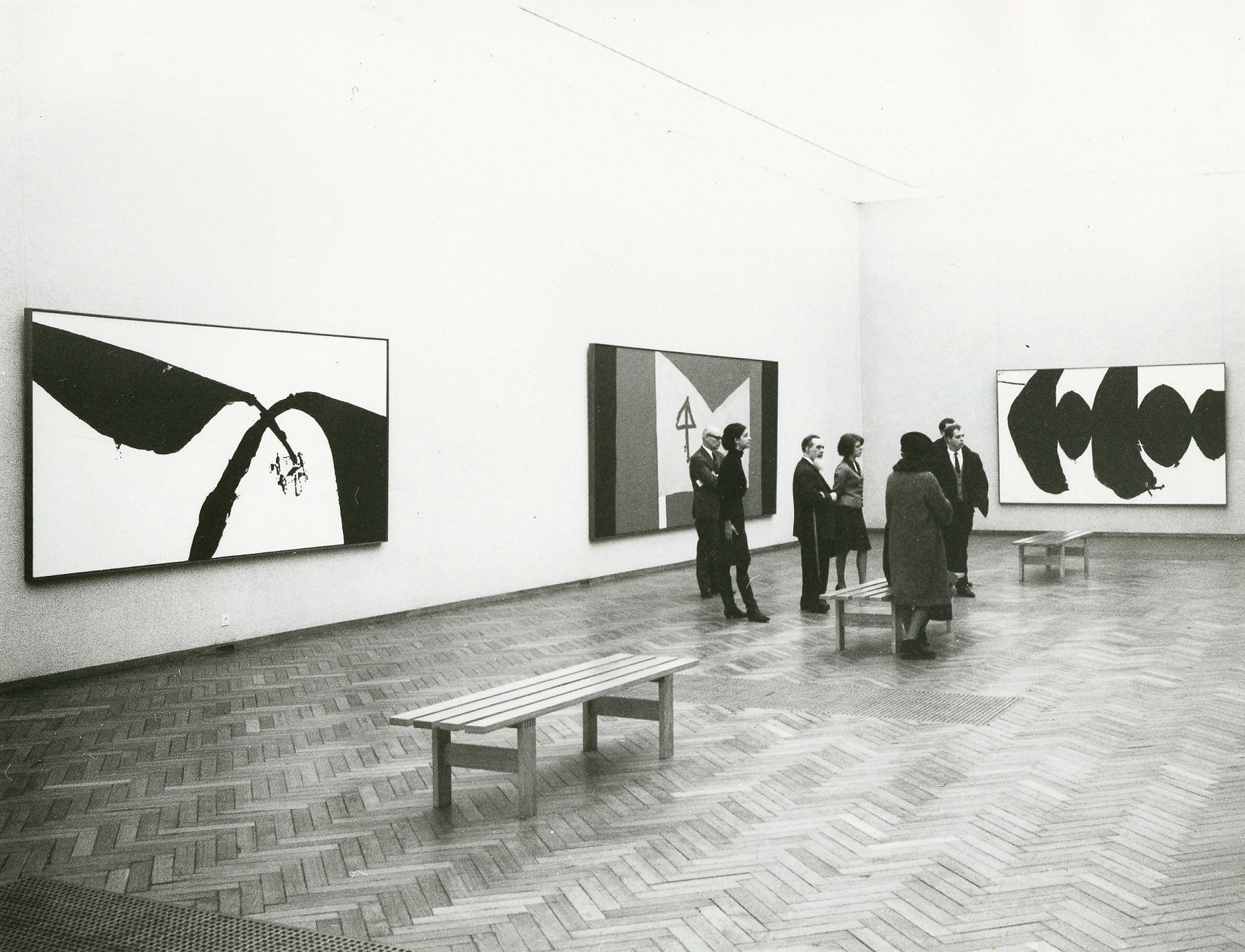
In fact, although Motherwell was not involved in the installation of the European venues of his MoMA retrospective, it is clear from his earliest solo shows that he took an active role in the presentation of his work. And when Motherwell participated in hanging his work, there were departures from the typical horizontal line of display characteristic of modern art exhibitions. Two noteworthy examples can be seen in photographs of his 1959 exhibition at the Sidney Janis Gallery: the staggered hang of Two Figures and Iberia No. 2, and a salon-style display of twenty-eight small paintings.[xviii] (This staggered hang was reprised at MoMA, where The Voyage sits off-center above Spanish Painting with the Face of a Dog and to the left of Iberia No. 2, and where two large Je t’aime paintings from 1955-57 are placed above and amidst small works from 1957-1964.) He would continue working on the installation of his solo exhibitions into his later years, most notably his 1983-1985 traveling retrospective. Before the opening at the first venue, the Albright-Knox Art Gallery in Buffalo, he spent a day rehanging the show. And for the final venue, at the Solomon R. Guggenheim Museum, which contained a significantly different selection, Motherwell installed a group of forty-two drawings salon-style, echoing the way in which he hung works in his home and studio.[xix]
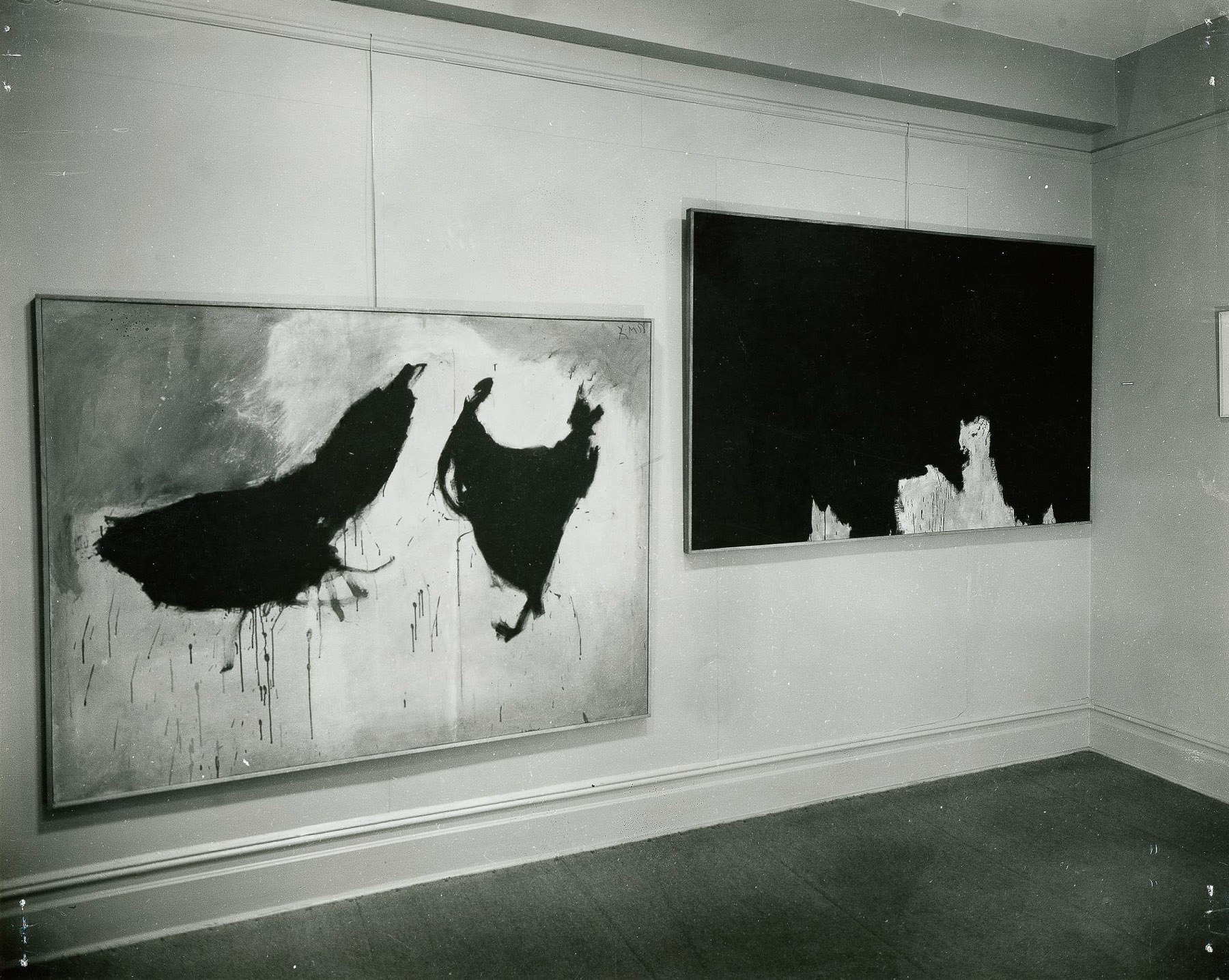
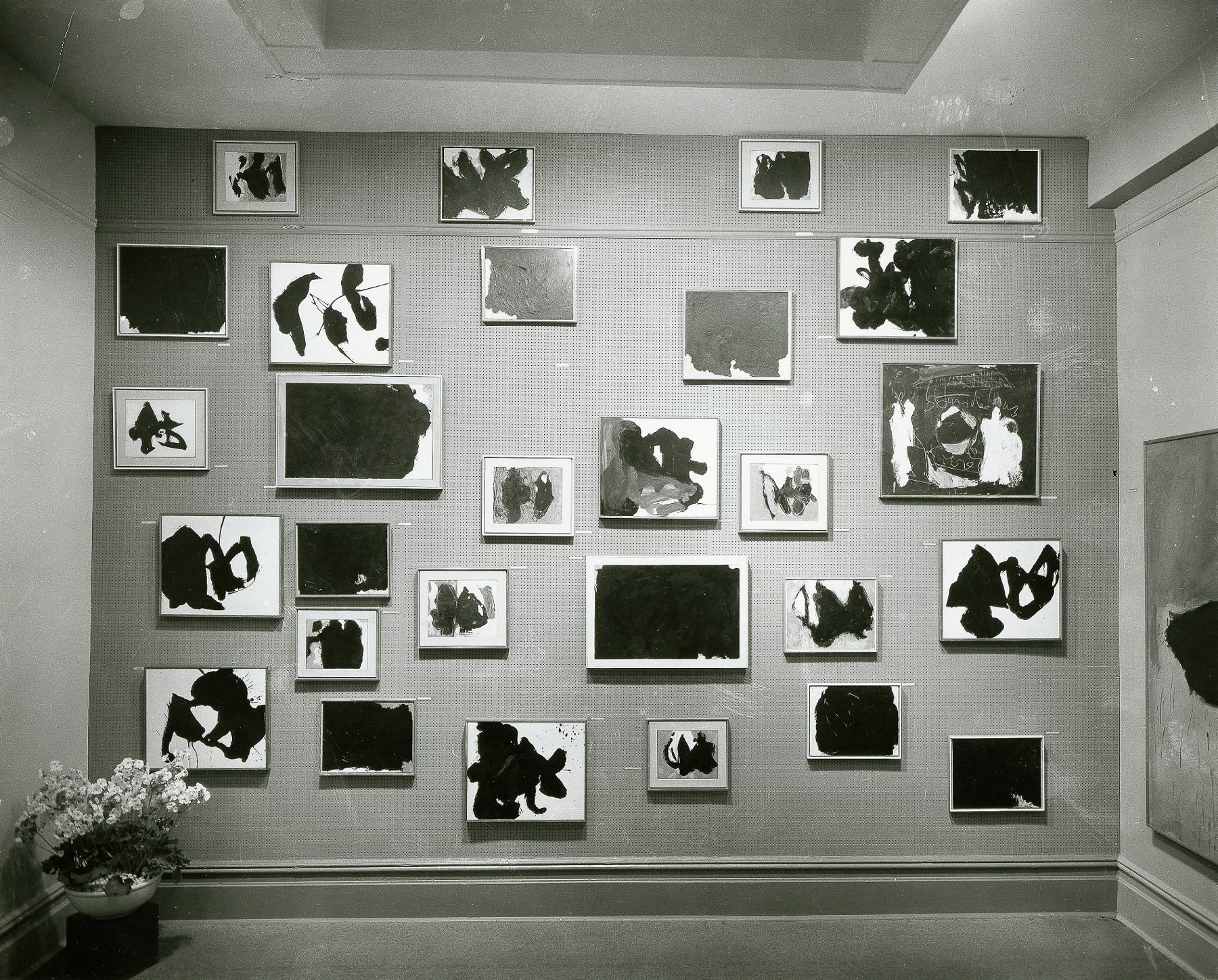
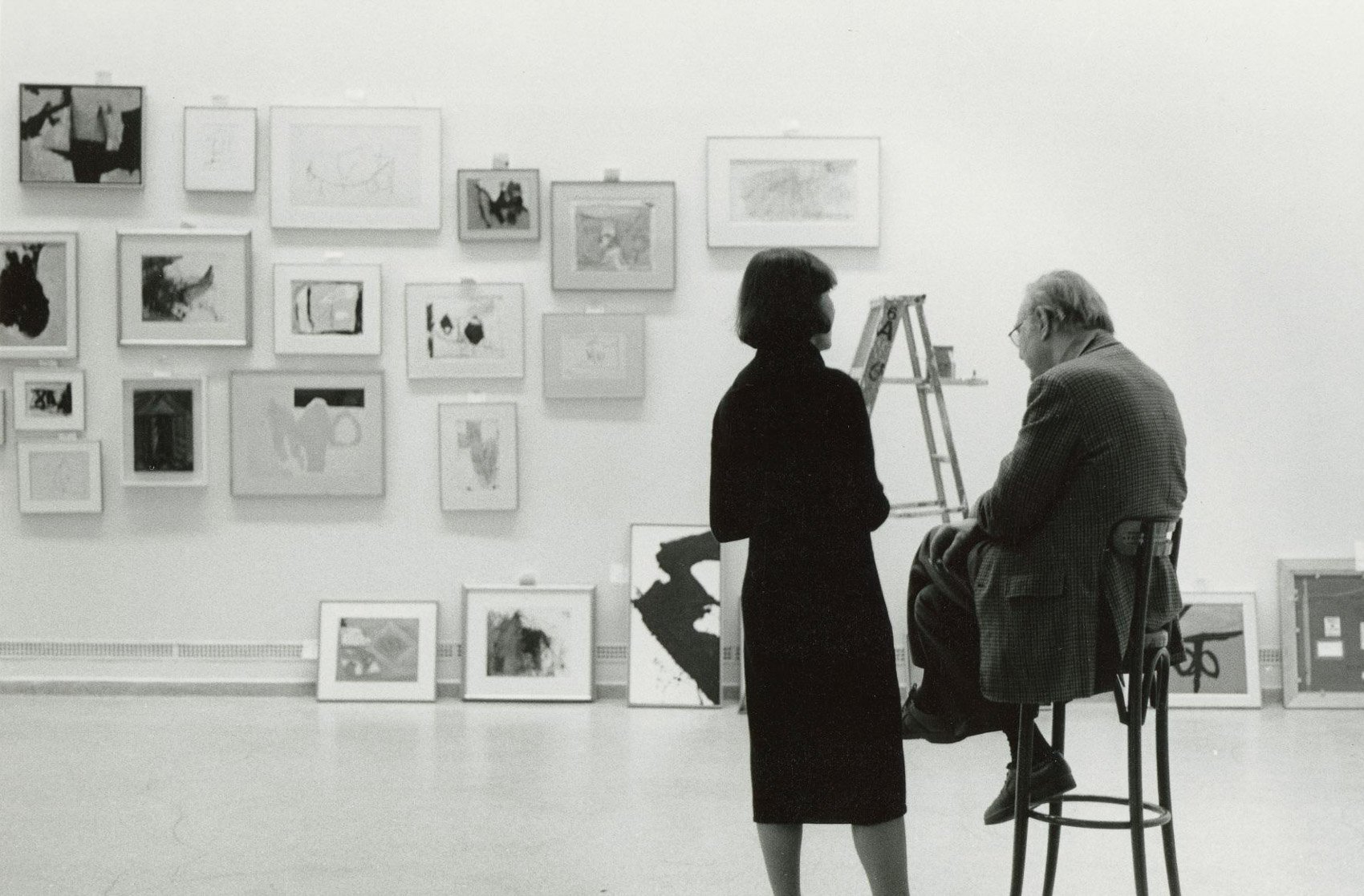
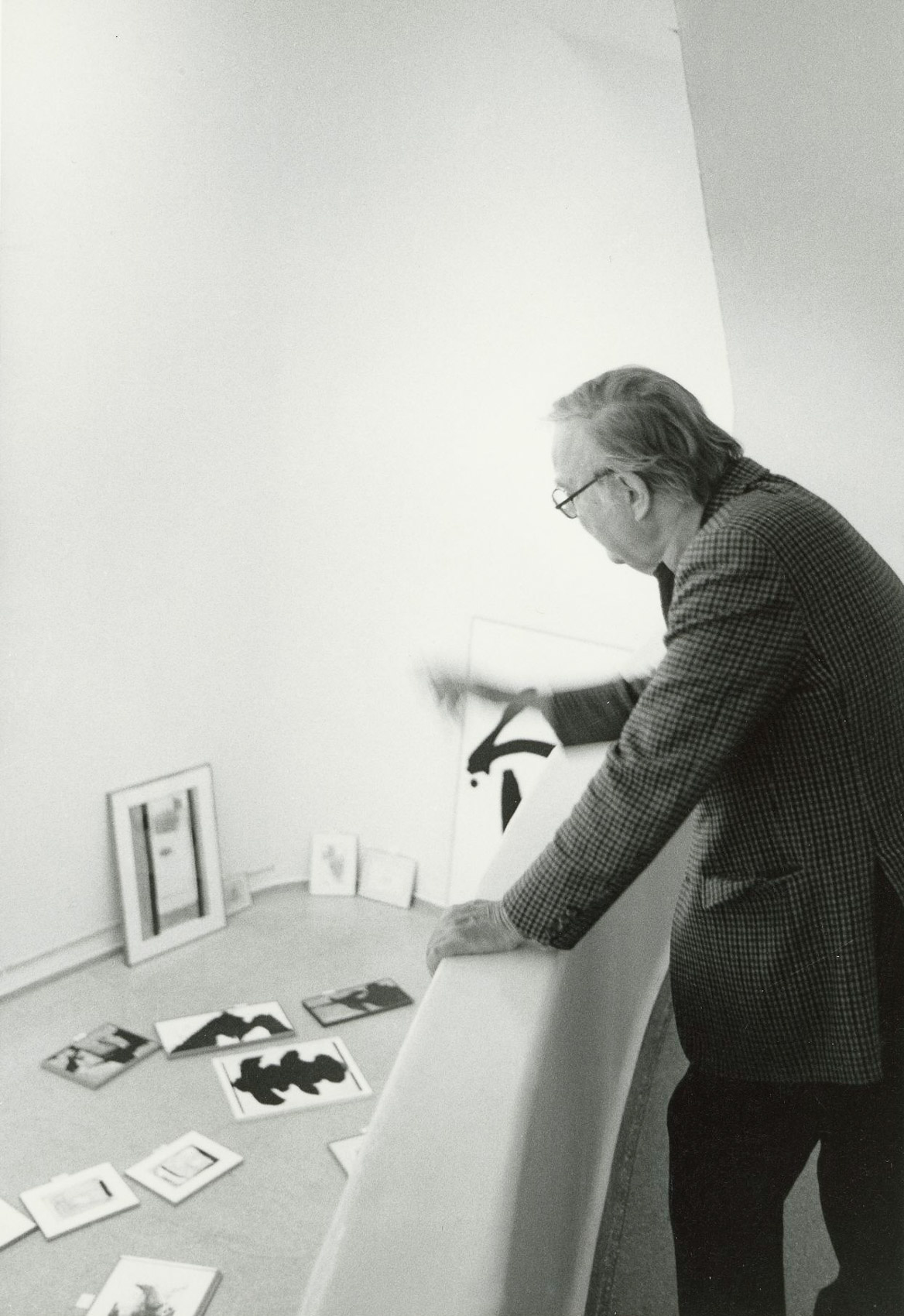
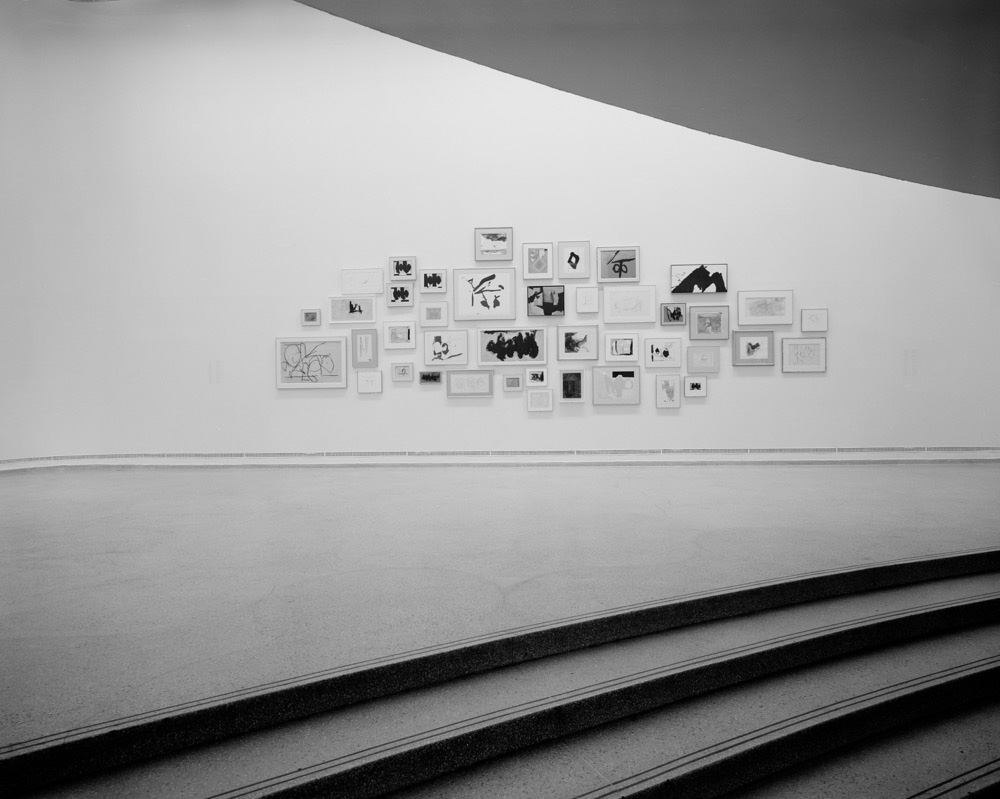
Motherwell’s 1984 retrospective at the Solomon R. Guggenheim Museum
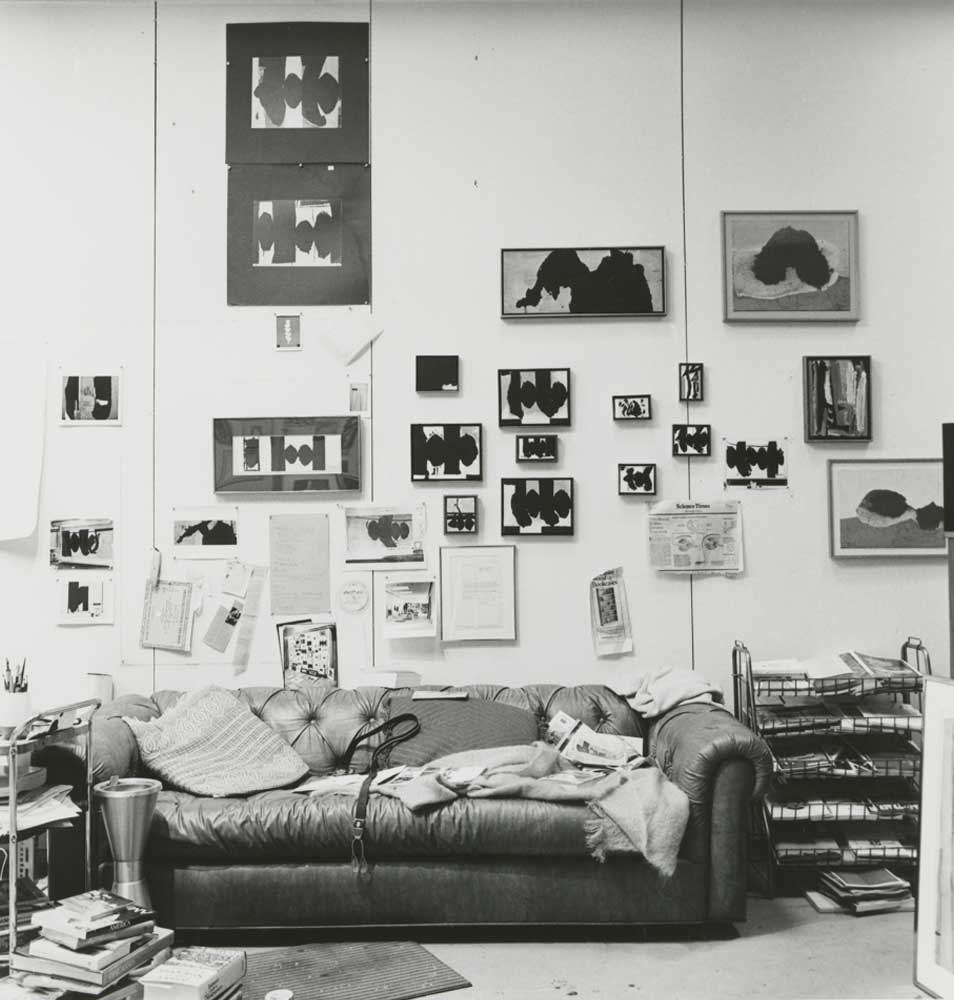
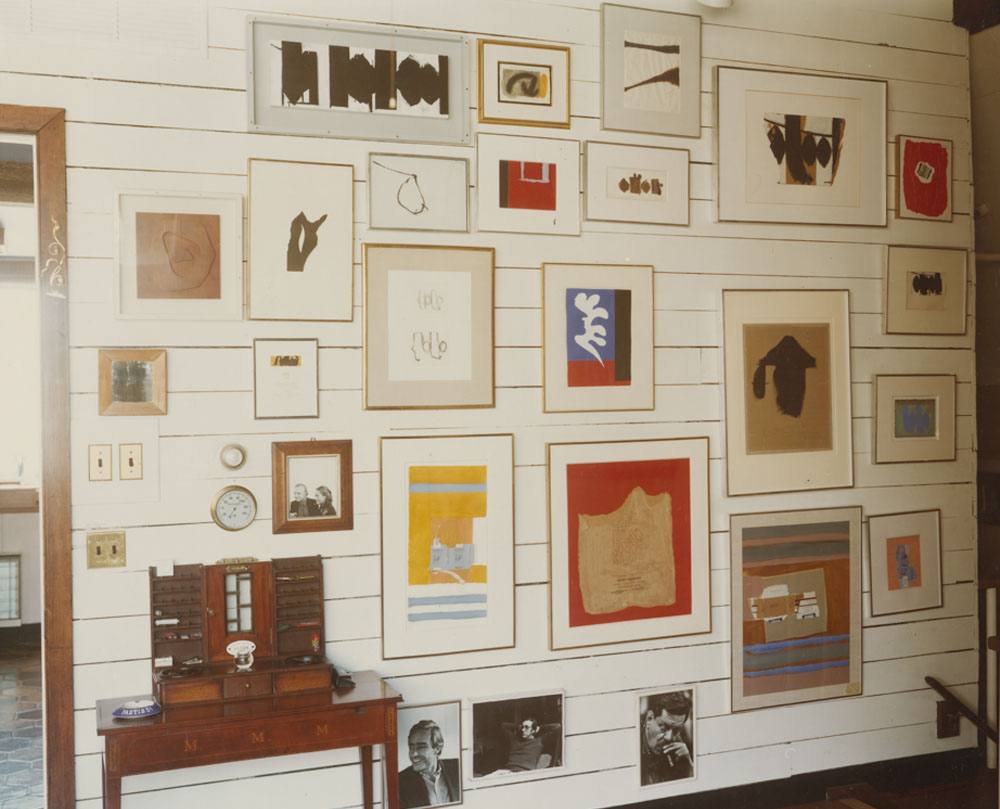
One effect that Motherwell sought in his work — an intention that he attributed to modern art in general, and to abstract art in particular — was a healing of the “sense of gulf, an abyss, a void between one’s lonely self and the world.”[xx] Motherwell associated this notion with Romanticism, which he had studied at Harvard with Arthur O. Lovejoy. But the existentialist tone of his intention was characteristic of the immediate Post-War period, similar to Isamu Noguchi’s statement for MoMA’s 1946 exhibition Fourteen Americans, a show for which Motherwell also was selected, and in which the work of the sculptor was seen as part of “the constant transfusion of human meaning into the encroaching void.”[xxi]
Motherwell’s existentialist ideas and approach to exhibition connect with the centrality of collage in his practice, in which the assembling of disjunctive elements constituted, as Jack Flam has remarked, “a way of responding to the discontinuities of the modern world.”[xxii] Given Motherwell’s way of thinking of exhibitions as analogous to artworks, generated by a series of decisions based on feeling so as to provide an experience of some intensity, it is natural to view his selecting and installing of exhibitions in this light. For him curatorial work would be a collage-like effort, choosing and putting together disparate elements to form a formally and emotionally powerful whole.
Motherwell’s artmaking decisions were not only aesthetic ones; they also had an ethical dimension. In a 1964 television interview with British curator Bryan Robertson, he was asked for an “all-embracing” statement about his work, and his response concerned “the ethical character of art.” Here he did not mean what ordinarily comes to mind when ethics is mentioned, but rather what the artist “insists on having in a picture, and what equally strongly he cannot allow in a picture,” what he called the artist’s “moral acceptances and rejections.” His own list of the former includes “immediacy, passion or tenderness, sheer presence, beingness as such, objectivity, and true invention and resolution, light, the unexpected, direct color, … and a certain broad masculinity and emotional weight….” On the other side, “no nostalgia, no sentimentalism, no propaganda, no spelling out to the vulgar, no autobiography, no violation of the nature of the canvas as a flat surface, no cliches, no illusionism, no descriptions, no seduction, no charm, no relaxation, no mere taste, no obviousness, no coldness.”[xxiii] Other artists, he emphasized, have different sets of values. But each artist has their own set, which is manifested in their work.
Motherwell here delimits a diverse array of particulars, their unity coming from the preferences, desires, and needs of an individual engaged in a given practice. The specificity is striking, generating a constellation of values unique to that artist. And just as artists have different values, so do different curators. We can see Motherwell’s unhappiness with his 1965 MoMA retrospective as in part generated by a conflict in such basic values, with Motherwell wanting to display resolved works and Frank O’Hara wanting to emphasize risk and struggle.
In a letter to Motherwell written a month before the exhibition opened, O’Hara urged that the show not be cut down any further, arguing that the large number of works was necessary to show “your own uniqueness, and nothing can be gained by avoiding it or trying to edit it, since it is your vitality and strength. …part of the uniqueness is a big, swinging, open-minded variety of experience between you and your art where you are willing to fall on your face if necessary to get the experience in paint or in paper. We haven’t included any where you did land that way, but what we have I think has the thrilling atmosphere of your willing to if you have to.”[xxiv]
This suggests that not only did Motherwell seek to avoid a standard art historical exhibition, but also that he did not want to exhibit the precariousness of his practice. Intense feeling was essential to his work, as were signs of process and revision. Yet what was shown ideally were to be resolved paintings and collages presented through an aesthetically unified exhibition experience. It is important to note that for Motherwell such a unified exhibition experience did not preclude the works shown being of diverse kinds, for he felt strongly that his exhibitions should combine different sorts of paintings with different themes.[xxv] But given his self-doubt and the importance of a MoMA retrospective, Motherwell was not comfortable with O’Hara’s goal of a show that displayed the uncertainties of the artist’s process.
Tensions between artists and curators generally have been discussed in the context of thematic group shows, common examples being those of curators employing concepts that artists believe misrepresent their work.[xxvi] But as João Ribas has pointed out, exhibition studies largely have ignored solo shows.[xxvii] And the solo exhibition provides a natural and focused setting for considering the relationship between artist and curator in the exhibition process. Motherwell’s 1965 MoMA retrospective is a fascinating case of divergence of intention, highlighting different conceptions of the exhibition and the personal dynamics within which they operated. And studying these factors provides a useful beginning for looking more closely at Motherwell’s involvement in the exhibition of his work, and at the ideas that figured into that engagement.
. . . . .
Endnotes
[i] For details of Motherwell’s work at Stanford and Harvard, see Tim Clifford, “Chronology,” in Jack Flam, Katy Rogers, and Tim Clifford, Robert Motherwell Paintings and Collages: A Catalogue Raisonné, 1941-1991, Volume One: Essays and References (New Haven and London: Yale University Press, 2012), 181-182. For Motherwell’s account of the importance to his painting of his study of philosophy, see Robert Motherwell, “Oral History Interview with Robert Motherwell, 1971 Nov. 24-1974 May 1,” interview for the Archives of American Art by Paul Cummings, https://www.aaa.si.edu/collections/interviews/oral-history-interview-robert-motherwell-13286#transcript, and “On Not Becoming an Academic” in Stephanie Terenzio, ed., Collected Writings of Robert Motherwell (Oxford: Oxford University Press, 1992), 278-280.
[ii] William R. Dennes. “The Aesthetic Works of D.W. Prall: A Review Article,” Journal of Aesthetics and Art Criticism 26, no. 3 (Spring 1968): 391-394. Prall’s most important book was Aesthetic Analysis (New York: Thomas Y. Crowell, 1936), published the year before Motherwell arrived at Harvard. He was a charismatic teacher, with whom Motherwell took a class on Spinoza and worked independently on aesthetics. Motherwell also joined some Harvard students who met regularly at Prall’s apartment, a group that included Leonard Bernstein and Delmore Schwartz.
[iii] “Interview with Bryan Robertson, Addenda,” in Terenzio, ed., 142.
[iv] “Beyond the Aesthetic” (1946), in Terenzio, ed., 37. Here Motherwell is writing about collage, but the point he makes is a general one concerning abstract art. This essay, written for an issue of Design magazine devoted to Black Mountain College, where Motherwell taught in the summer of 1945, largely concerns the importance of feeling in both the creation and experience of works of art. In the brochure for his April 28-May 17, 1947 exhibition at the Samuel M. Kootz Gallery, Motherwell reiterates the role of feeling in his painting process: “I begin a painting with a series of mistakes. The painting comes out of the correction of mistakes by feeling.” https://dedalusfoundation.org/robert-motherwell/exhibitions/motherwell/
[v] Frank O’Hara. “The Grand Manner of Motherwell,” Vogue 146, no. 6 (October 1, 1965): 263.
[vi] Robert Motherwell, “What Should a Museum Be?” Art in America, March 1961, in Terenzio, ed., 131.
[vii] Terenzio, ed., 132.
[viii] For Motherwell’s comments on his 1965 MoMA retrospective, see Motherwell, “Oral History Interview.”
[ix] There were a few chronological disjunctions, such as the installation of The Voyage from 1948-49 above Spanish Painting with the Face of a Dog and Iberia No. 2 from the late Fifties. And in a letter to Motherwell, O’Hara mentions that he planned “to install in a small crowded slightly off-main gallery where the whole point will be the gorgeous mixing of periods, tough little oils and elegies….” Frank O’Hara to Robert Motherwell, August 26, 1965, Archives of The Dedalus Foundation. For installation photographs of the exhibition, see https://www.moma.org/calendar/exhibitions/2920?installation_image_index=0.
[x] In a fascinating comparison, O’Hara took Wallace Stevens’s poem Thirteen Ways of Looking at a Blackbird as “almost a paradigm of Motherwell’s conception of the ‘series,’ in which variations on a visual motif invite the artist and the viewer to see things with as much ingenuity and insight available to each without violating the essential identity of the initial image.” O’Hara, “The Grand Manner of Motherwell”: 264.
[xi] “…with any show or with a picture itself you edit it. And I was put in a position where I could not edit anything.” Motherwell, “Oral History Interview.”
[xii] Motherwell, “Oral History Interview.”
[xiii] For an overview of these developments, see Andrew McClellan, The Art Museum from Boulée to Bilbao (Berkeley: University of California Press, 2008), 120-140.
[xiv] James J. Sheehan, Museums in the German Art World: From the End of the Old Regime to the Rise of Modernism (Oxford: Oxford University Press, 2000), 40.
[xv] Maria Gough, “Futurist Museology,” Modernism/modernity 10, no. 2 (April 2003): 340.
[xvi] Edy de Wilde to Robert Motherwell, February 6, 1966. Archives of The Dedalus Foundation. The European venues of the MoMA retrospective were the Stedelijk Museum (Amsterdam), Whitechapel Art Gallery (London) (initiated by Bryan Robertson before the MoMA show), Palais des Beaux-Arts (Brussels), Museum Folkwang (Essen), and Galleria Civica d’Arte Moderna (Turin).
[xvii] Robert Melville, “Black Devices,” New Statesman, April 1, 1966. Not only spectacle was applauded in the MoMA installation of the “Elegies” but also the emotional power of the group, displaying “affecting proxies…of the artist’s deepest apprehension, unfolding in the slow, full beats of a pictorial pavane.” Max Kozloff, “Motherwell,” Nation 201, no. 12 (October 18, 1965): 257. For additional perceptive remarks occasioned by the MoMA retrospective, see Lucy R. Lippard, “New York Letter: Miro and Motherwell,” Art International 9, no. 9-10 (December 20, 1965): 33-35.
[xviii] For installation photographs of this exhibition, see https://dedalusfoundation.org/robert-motherwell/exhibitions/robert-motherwell-4/
[xix] For critical appraisals of the 1983-1985 retrospective, see Jack Flam, “Paintings, 1975-1991: Inventions and Reinventions,” in Flam, Rogers, and Clifford, Robert Motherwell Paintings and Collages: A Catalogue Raisonné, Volume 1, 163-165. Motherwell can be seen working on the installation at the Guggenheim, including the wall of drawings, in the documentary Robert Motherwell and the New York School: Storming the Citadel, produced and directed by Catherine Tatge, PBS American Masters, 1991. An excerpt by Alain Chivilò for Contemporary Art Musa can be seen on YouTube Video, 15:04. https://www.youtube.com/watch?v=ZxCCa-j9T_s. Accessed June 6, 2022.
[xx] Robert Motherwell, “What Abstract Art Means to Me,” in Terenzio, ed., 86.
[xxi] Dorothy Miller, ed., Fourteen Americans (New York: Museum of Modern Art, 1946), 39.
[xxii] “Why Robert Motherwell Would Have Loved The Art Genome Project…and More from Jack Flam, President of the Dedalus Foundation,” posted May 27, 2013, https://www.artsy.net/article/editorial-why-robert-motherwell-would-have-loved-the
[xxiii] “On the ethical character of art, 1964,” from ART: New York, ‘Robert Motherwell: Theme and Variations.’ With Bryan Robertson (New York: WDNT-13, Broadcast December 15, 1964). Video, 3:29. https://vimeo.com/64579584. Accessed June 6, 2022.
[xxiv] Frank O’Hara to Robert Motherwell, August 26, 1965. Archives of The Dedalus Foundation.
[xxv] A particularly clear example of his exhibiting a variety of painting types in a single show was his November 14-December 5, 1950 exhibition at the Samuel M. Kootz Gallery, Motherwell: First Exhibition of Paintings in Three Years. The brochure enumerates and describes three categories of paintings: Elegies, Capriccios, and Wall Paintings. https://dedalusfoundation.org/robert-motherwell/exhibitions/motherwell-first-exhibition-of-paintings-in-three-years/, accessed September 30, 2023.
[xxvi] The paradigm here is the 1972 protest of ten American artists against the curator of Documenta 5, Harald Szeemann, for seeking to present their work under categories that they had not approved. For these artists’ reaction to Documenta 5, see Bruce Altshuler, Biennials and Beyond: Exhibitions that Made Art History, 1962-2002 (London and New York: Phaidon Press, 2013), 157-159, and Friedhelm Scharf and Gisela Schirmer, “Off the Wall: Artists’ Refusals and Rejections: A History of Conflict,” in Michael Glasmeier and Karin Stengel, eds, Archive in Motion (Gottingen: Steidl, 2005), 119-126.
[xxvii] João Ribas, “Notes Towards a History of the Solo Exhibition,” Afterall Journal 38 (Spring 2015): 4-15.

